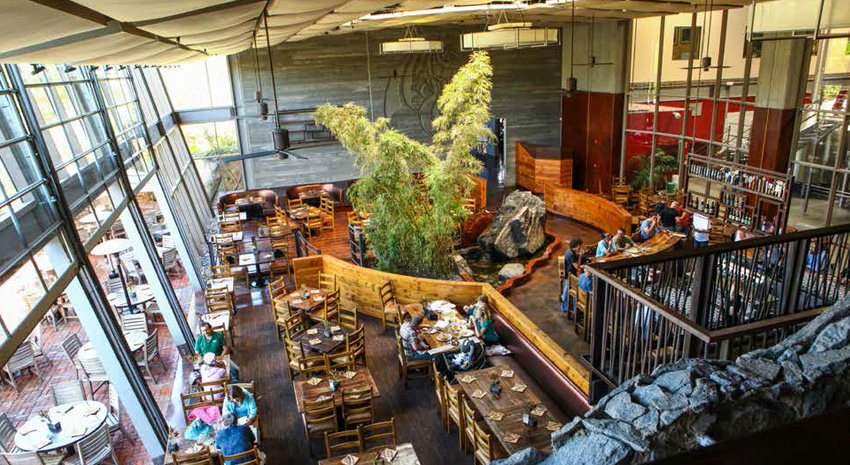March 2017, United States

Photo: Stone Brewing main dining room and bar © STONE BREWING
WITH GLORIOUS BEACHES, reliably mild weather and world-class attractions, San Diego is often called America’s Finest City. The country’s 17th-largest metropolitan area is also a business hub, and no matter whom you ask, the answer is always the same: The local economy’s top three sectors are innovation, tourism and the military. New developments are reinvigorating all three.
With visitors bringing $10 billion a year into the local economy, tourism remains the city’s second-biggest factor. The renowned San Diego Zoo, Sea World, the USS Midway Museum — along with the seashores and golf courses — continue to attract thousands of domestic and international visitors each year, principally from China, Mexico, Canada and the United Kingdom. Recently built underground parking garages that expand parks and open space further enhance the urban atmosphere.

ZOOKEEPER FEEDING CHEETAHS AT THE SAN DIEGO ZOO © WOLLERTZ | DREAMSTIME.COM
Brewery bus tours represent an emerging draw. Generating $851 million in sales last year and employing 4,500 workers, craft beers are booming, with 114 homegrown breweries organizing trips and tasting events. Stone Brewing, the largest, invites guests to its restaurant and tap room and is currently building a beer-themed hotel next to its major plant. This will join other new hotels now under construction downtown after a post-recession lag.
Perennially ranked among the country’s top five destinations for meetings and events, the San Diego Convention Center brings an annual $1 billion into the regional economy. With the immensely popular annual Comic-Con convention straining its facilities, the tourist bureau, hotel and restaurant association, city and port authority are reviewing potential plans for expansion. Earlier this year, the city shelved the potential construction of a new downtown stadium when the San Diego Chargers football team made the decision to relocate to Los Angeles.
The military sector runs a close second to tourism. Home port of the Pacific Fleet and one of the country’s largest naval bases, San Diego supplies support services from housing and food to medical care and counseling. With military forces shrinking in numbers amid a shift to tactical strategizing, the city is seizing on new technological opportunities to attract more government investment to the city.
And military advances are only one aspect of the blossoming business innovation in biotech, medicine, life science, engineering, energy, clean green, solar and HVAC — startup businesses which expanded exponentially during the past 15 years. In contrast to Stanford, which attracts major Silicon Valley angel investors, San Diego boasts a network of community-based centers providing guidance and mentorship to grassroots innovators. Stoked by the preponderance of military veterans and the University of California at La Jolla, which attracts many Asian students, the region is ripe with ideas that transform into viable businesses.
Industry is sustained by a cross-border labor force that enables engineering and manufacturing resources south of the border in Baja to buttress the innovative activity up north. To facilitate that exchange, the city approaches the locale not as two nations but as one Cali-Baja region and is making efforts to build bridges and ports of entry.
Fortifying development, a city charter passed last year dedicates a specific percentage of revenue to infrastructure, targeting improved roads, increased water and sewer capacity, and water recycling. A seawater desalination plant recently came online to ensure access to the fresh water crucial not only to the population but also to manufacturing and biotech.
Rebounding after the recession, prices are back up, in some cases to record highs. Neighborhoods are hitting their stride, particularly in the downtown area. The same attributes that attract tourists also appeal to residents who appreciate the easy access to hiking, bicycling, swimming and climbing. That outdoor culture draws free thinkers who also make great employees, luring companies to relocate here. “It’s a beautiful, innovative, creative city,” a Chamber of Commerce spokesperson explains, “a place where you’d like to live and work.”
SCENIC DRIVES
While beer commands the city proper, nearby wineries offer attractive daytrips. Drive north on Route 15 past citrus groves and vine-covered hillsides through Escondido to Temecula, where antique shops and wine-tasting bars await behind the Western frontier façades of Old Town. A half dozen local, family-owned wineries lie east of town along Rancho California Road. Sample a full line of varietals and vintages at Bel Vino. Trendy Miramonte is apt to offer live entertainment for those sipping wines it calls “adventurous and succulent.” Along with its award-winning wines, Callaway Winery’s Meritage Restaurant offers farm-to-table meals and panoramic views. Thornton Winery is designed like a French château, and early California-style Mount Palomar Winery overlooks the valley.
South of the border explore Valle de Guadalupe, an emerging region of up-market wines and dining. Locals recommend taking the Tecate border crossing to a ride through rolling hills on Mexico Highway 3. L.A. Cetto is one of the largest producers; Paralelo boasts a fruity Sauvignon Blanc; and 20-year-old, family-run Casa de Piedra produces some of Mexico’s finest wines.
